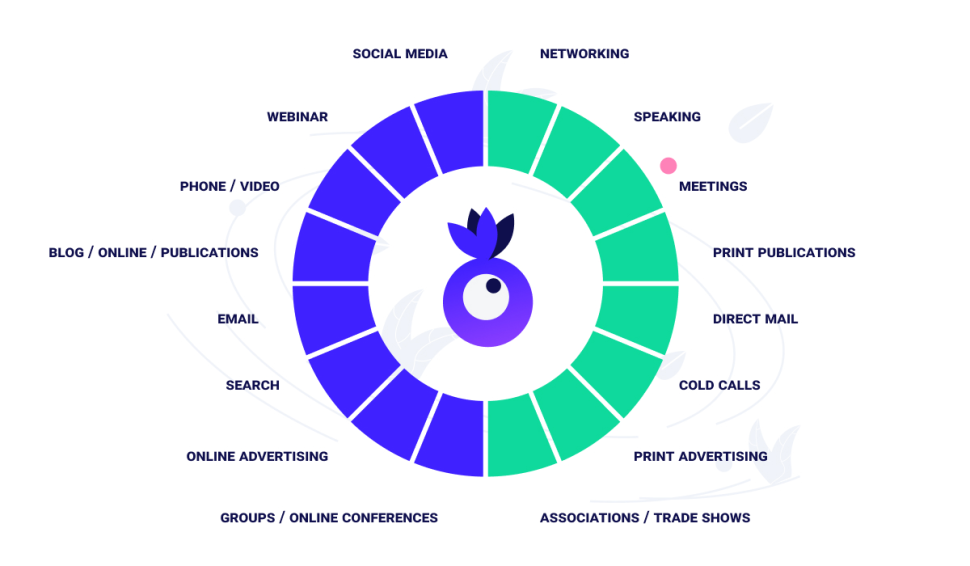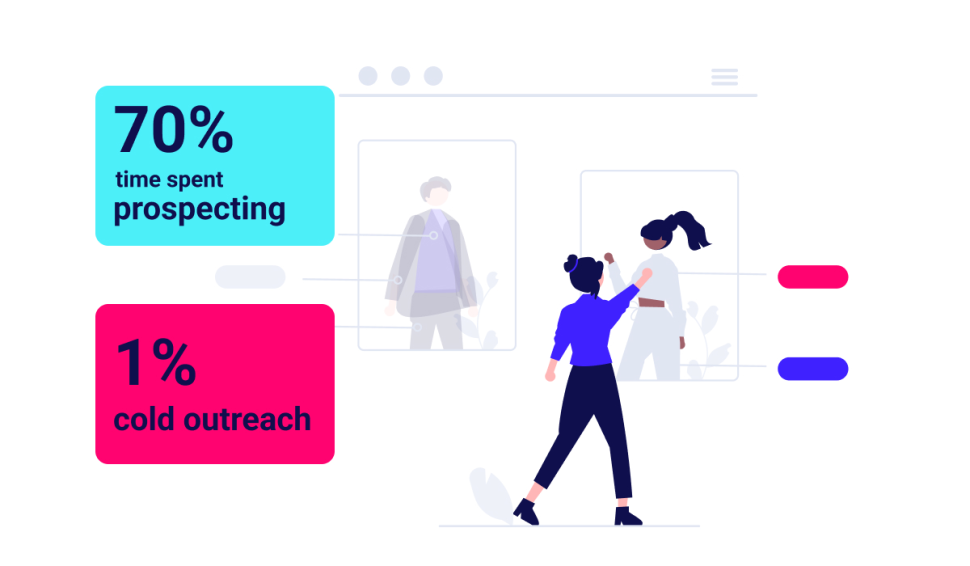Truebase Blog
Valuable information from industry professionals
How to upgrade your outdated sales lead generation process?
Wissam Tabarra
May 23

How often do you upgrade your wardrobe? I am guessing every year or maybe every two years, but I am sure that you aren't wearing your teenage clothes.
Of course, they wouldn't fit you, and even if they did they are probably out of fashion.
So why would you drag along a sales lead generation process that is outdated? I know why, because it isn't easy to figure out that a process is outdated.

Also, we are more likely to stick with old traditions and processes than we are to stick around with old clothes.
Regardless of whether you know that your lead generation process is outdated or not it is bound to cost you millions or hundreds of thousands depending on the size of your target market.
In this article, I intend to save you that money and add it to your bottom line by doing two things - 1) help you identify signs that point to an outdated sales lead generation process and 2) steps you can use to upgrade your lead generation process.
Let's get started with the signs of the outdated lead generation process.
Sign #1: You are overly dependent on offline marketing
In the offline world, lead generation is a term used to describe how businesses find and generate leads at events and offline media (newspapers, magazines, etc.). It can also be described as using offline tactics like seminars and direct mail.
Typically companies who depend on offline lead generation strategies are those that have not kept up with the pace of technology or those that lack an effective website.
For instance, you can use some catchy website popup for your site to attract and generate more leads.
Simply put, if you are overly reliant on these channels you haven't upgraded your sales process in years.
Sales processes should never stagnate; they should always be evolving as new technologies emerge. Most importantly, their goal should remain the same - to drive revenue into your company. Yet many organizations fail to evolve their lead generation process beyond direct mail and trade shows.

This can lead to wasted time and money as well as result in fewer sales-qualified leads.
Those are just a couple of signs that point to an outdated lead generation process.
If you don't want to find your lead generation strategies becoming obsolete, it's important to keep up with new forms of lead generation such as social media, email marketing, and online PR.
Sign #2: You make decisions based on gut-feeling not based on data
According to the Harvard Business Review, sales reps choose their prospects for sales outreach based on their "gut feeling" (45% of the time) and not on data (15%).
This is one of the biggest signs that sales development teams are using an outdated sales lead generation process.
When sales teams use gut feelings as a sales qualification tool, they may miss out on sales-ready leads and focus on low-quality leads which result in lost revenue. In addition, these sales reps often have no way to measure or quantify sales forecast accuracy.

Gut feeling sales qualification is subjective, not objective.
In addition, according to the Harvard Business Review, sales development teams who rely on gut feelings lead to higher sales forecast errors and poor sales forecasting accuracy. These kinds of forecasts generate overspending as well as lost revenue.
If you want to avoid these common mistakes, data must drive your lead generation strategy.
So if your reps are choosing accounts and leads for their outreach based on gut feeling, stop and acknowledge that you have a problem.
Sign #3: You see an average reply rate from your cold email outreach
This sign is one that most cold emailers are familiar with.
It invokes fear and panic as they wonder whether or not their cold email outreach efforts are effective.
Let's be honest, nobody wants to see an average cold email reply rate of 1%.
Would you call a hand in poker if you knew your odds of winning were just 1%?
Your cold email reply rates should not be this low. If you do see your cold emails getting below-average response rates - double down on new templates, segment ideas, personalization practices, etc.
You can also talk to your peers who may have had success in increasing cold email replies to get a better idea of what's working for them.

The possible causes might be outdated lead generation software, poor targeting practices, outdated cold email sequences, etc.
To summarise here are some signs that point to an outdated lead generation process: you depend overly on offline marketing; you make decisions based on gut feeling, not data; and lastly, you see an average reply rate in your cold emails.
Now that you are aware of some signs of an outdated lead generation process, let's look into how you can upgrade it.
Prospect faster and with precision using AI.
First, you must upgrade lead generation software. You can't lead development reps with tools that aren't keeping up with the latest trends in lead generation.
Second, start using the latest prospecting software to generate sales-ready leads faster. Using AI-based lead generation platforms like Truebase gives sales teams an edge by finding the best prospects based on their buying behavior.
For example, by identifying the business size or industry of a company, sales reps get tailored lead lists based on their criteria (such as location) and account behaviors (such as web activity). This kind of insight provides sales teams with more targeted lists which drive higher open and reply rates than ever before.

Finally, lead generation software depends on analyzing unstructured data from the web to generate sales-ready lead lists for their users.
One of the most commonly used lead generation features is lead recommendations and lead suggestions. These lead recommendations and lead suggestions are generated by collecting information from social media, job postings, industry events, etc. - all of which help reveal buying signals at specific companies. This means you can quickly find prospects that fit your criteria such as size, location, or industry.
With more targeted campaigns, your reps will have greater success in their outreach and contribute more to the bottom line.
Warm-up cold accounts with awareness campaigns
The cold outreach process is long and sometimes strenuous. A cold email can be ignored, cold calls can go straight to voicemail, and show-up rates on cold LinkedIn messages are often sub-par.
This is why you must warm up cold accounts with awareness campaigns across multiple channels like email, ads, cold calls, and others.
I say this because very few companies are ready to buy at any given time - they usually need nurturing into buying products so that when they do reach out to you they're sales-ready.
According to a recent survey conducted by The Bridge Group, nearly 75% of marketing leads will require nurturing before the lead is considered sales-ready.
With over two billion dollars in marketing spending going towards nurturing programs, this number is expected to increase over the next few years.

When cold accounts are nurtured through awareness campaigns, they become ready leads and ultimately close more deals with less effort.
By no means does cold outreach end when you get the cold account's email address or phone number; it begins then. Warm-up cold accounts with awareness campaigns by using strategies like these:
Postcard mailers for high-volume cold accounts (yes, like direct postcards).
Email drip campaigns that include promotional content targeted at your cold leads' business pain points
Sponsored ad campaigns for select email addresses based on their buying stages.
Get warm intros from your network
According to LinkedIn's 2016 report, warm referrals make up for 38% of all new business opportunities. With warm intros, you cut down on the time of finding leads by 50%.
Since getting a warm intro to each prospect might be difficult, it is advisable to use your entire team's professional network and also to consider multiple channels for finding an intro.

With the help of software like Truebase, you can find warm intro opportunities for your prospects and increase your chances of getting a reply by at least three times. Also with multiple channels like Gmail, LinkedIn, Twitter, and others to search from, you can increase your chances of finding a warm intro.
Engage with buying group members with relevant messages
Your lead generation strategy should include messages that not only address the lead but also all members of their buying group.
Lead generation benefits greatly when sales reps craft relevant messages to buying group members based on their role in the buying group.
Some sales reps engage with lead prospects by sending out a blanket email to everyone at the lead's company. This is not only time-consuming but also ineffective.
Why?
You cannot expect all lead prospects to engage in the same way. Some might be interested and open the email, while others might delete it right away because they don't need your product or service.
So how do you reach out to lead prospects effectively? Always craft messages targeted at buying group members based on their role in the buying group. Also, you should identify the best-suited channel for each role.
For example, sales managers tend to check their emails more often than lead marketers, so sending a sales manager a note on LinkedIn about a new product launch will increase engagement levels from that lead prospect significantly.
By engaging with buying group members using relevant messages and the right channel you can greatly improve your lead generation process.
Learn faster and increase your conversion rates with each prospecting cycle.
This last suggestion is more of a mindset change that I am proposing. Most sales managers want to shorten the sales cycle but rarely do they plan to shorten the prospecting cycle.
The latest prospecting software can learn from your existing campaign results, your previous prospecting behavior and suggest your accounts and leads based on those learnings.

This is important because it ensures that reps aren't stuck in a rut and committing the same mistakes during every prospecting cycle. By learning from previous campaigns, you can better define your ICP and increase conversion rates from your outreach without much effort.
So how are you going to upgrade your lead generation process? If you are serious about it, I would suggest you start with good prospecting software.
And while we are at it, you should try out a 14 day free trial of Truebase and see if it transforms lead generation for you before you suggest it to your team.
Have any questions? Drop a word at growth@truebase.io.
Activate precise AI to send you the best potential buyers weekly
Accelerate growth today! Let Truebase take over the tedious, manual tasks and do the heavy lifting, freeing you up to focus on what you do best: closing deals.
Start Trial
Prospect Faster. Connect smarter
© Truebase Inc, 2023. All rights reserved.